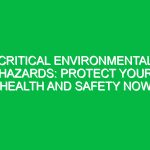Introduction
Hello team! Today, we’re here for a crucial Toolbox Talk on a topic that directly impacts your health and Safety while working: **Rabies in the US**. Rabies is a viral disease that can be deadly but is preventable through awareness and prompt action. In our work Environment, understanding rabies is not just about knowledge; it’s about actively protecting ourselves and our coworkers. So, let’s dive in and equip ourselves with the essential information regarding rabies, its risks, and how we can stay safe.
What is Rabies?
Rabies is a viral infection that affects the central nervous system, leading to brain inflammation and, ultimately, death if not treated. The rabies virus is primarily transmitted through the bites of infected animals. In the US, the most common rabies carriers include bats, raccoons, skunks, and foxes. Understanding the nature of rabies and its transmission is essential for preventing potential exposure while on the job.
How Does Rabies Spread?
The rabies virus spreads primarily through saliva from an infected animal. The most typical scenarios for transmission include:
- Bites: An infected animal bites a person, transmitting the virus through its saliva.
- Scratches: If an infected animal scratches you, the virus can enter through broken skin.
- Open Wounds: Contact with saliva from an infected animal through open wounds can also lead to infection.
It’s also important to note that while rabies is primarily associated with wild animals, domesticated pets can also carry the virus if they are not vaccinated.
Signs and Symptoms of Rabies
Rabies symptoms can take weeks or even months to appear after exposure. Early signs may include:
- Fever
- Headache
- General weakness or discomfort
- Itching or prickling at the wound site
As the disease progresses, more severe symptoms appear, such as:
- Confusion or agitation
- Difficulty swallowing
- Extreme sensitivity to light and sound
- Paralysis and coma
Recognizing these symptoms early on is vital for seeking medical assistance quickly.
The Importance of Vaccination
One of the most effective ways to prevent rabies is through vaccination. Vaccinating pets, especially dogs and cats, is crucial in preventing the spread of rabies. Additionally, workers in high-risk jobs, such as animal control or wildlife management, may consider receiving a rabies vaccination for added protection.
Potential Hazards and Risks in the Workplace
In our work environment, it’s essential to recognize potential Hazards related to rabies. Some risks include:
- Encountering wildlife or stray animals while on the job.
- Working in areas where rabies infection rates are known to be high.
- Handling animals that might be injured or behaving unusually.
Being aware of these risks is the first step toward protecting yourself and your coworkers.
Best Practices for Prevention
To minimize the risk of rabies exposure while on the job, follow these Best Practices:
- Avoid contact: Never approach or attempt to handle wild animals. If you encounter an animal acting strangely, keep your distance and alert the appropriate authorities.
- Report bites or scratches: If you or a coworker is bitten or scratched by an animal, report it immediately to your supervisor and seek medical attention.
- Vaccinate pets: Ensure that your pets are vaccinated against rabies and maintain their vaccination status.
- Educate yourself: Stay informed about rabies, its symptoms, and preventive measures.
By adhering to these practices, you can significantly reduce the risk of rabies exposure in the workplace.
Regulations and Standards
In the US, certain Regulations and standards govern Safety practices related to rabies. The Occupational Safety and Health Administration (OSHA) emphasizes the importance of Workplace Safety, including the management of zoonotic diseases like rabies. Employers must comply with osha regulations to ensure a safe working environment.
It’s crucial to understand that compliance with these regulations not only protects you but also fulfills legal obligations and safeguards the company. Familiarize yourself with company policies regarding animal encounters and rabies exposure to ensure you are prepared.
Real-Life Examples
Consider a scenario where a worker, while performing Maintenance in a wooded area, inadvertently encounters a raccoon acting strangely. Instead of approaching the animal, the worker remembers the Toolbox Talk and keeps their distance, notifying their supervisor instead. This quick thinking prevents a potential rabies exposure incident.
In another case, a pet dog that hasn’t been vaccinated bites a worker during a routine visit to a home. The worker recalls the importance of reporting the incident and immediately seeks medical help. This proactive approach allows for timely post-exposure prophylaxis, potentially saving their life.
These examples illustrate the importance of awareness and preparedness in our daily operations.
Open Discussion
Now that we’ve covered the essentials, I’d like to open the floor for discussion. Are there any questions or experiences anyone would like to share regarding rabies exposure? Have you encountered any situations related to wildlife or animal interactions at work? Sharing your thoughts can help us all learn and stay vigilant.
Conclusion
To wrap up today’s Toolbox Talk, I want to emphasize the critical nature of understanding **rabies in the US**. By being aware of the risks, recognizing the signs, and following Best Practices, each of you plays an integral role in maintaining a safe work environment. Your commitment to safety is vital not only for your well-being but also for the health of your coworkers.
Thank you all for your attention and for participating in this essential discussion on rabies. Let’s continue to look out for one another and promote a culture of safety in our workplace. Stay safe, and remember to always report any concerns related to animal encounters!


